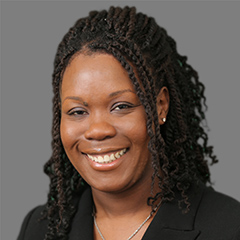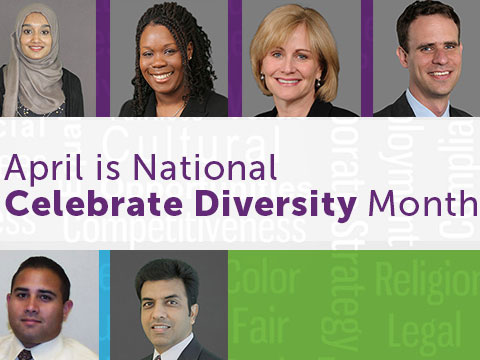I joined Mathematica in 2009 as a survey researcher. I finished graduate school under the cloud of the 2008 recession when many colleges and universities had hiring freezes and were retracting job postings. I felt fortunate to find a nonacademic job that would allow me to continue doing work I enjoyed and paid well. I was eager to join Mathematica, but one thing gave me pause. Everyone on my in-person interview team was White, and although I noticed plenty of women featured on the website, I saw very few racial and ethnic minority researchers. I shared my concern with a friend who worked at Mathematica, and my friend assured me that Black people did in fact work there, that it’s a great place to work, and that I would feel welcomed.
That experience 10 years ago set me—and Mathematica—on a course to think critically about what diversity means at a place like Mathematica; how to do a better job building more diverse teams; and how to ensure that as the company continued to grow, minority staff members had a chance to grow with it.
Now, as the acting chief diversity officer and a supervisor, I know that achieving our mission to improve public well-being begins with creating a workplace where all employees, regardless of background, have equitable opportunities to grow their careers.
When we launched our focused diversity and inclusion efforts in 2015, 75 percent of Mathematica’s U.S.-based staff identified as White, and within senior staff, the number who identified as White was even higher at 84 percent. When we took the time to survey employees and listen to what they said, we found that the numbers were only telling part of the story. The racial and ethnic makeup of the staff was one issue, but there were other, less visible signs simmering below the surface as well. For example, race and ethnicity along with other demographics played a role in staff reports related to supervision and mentoring.
Based on the findings, we implemented a modified Rooney Rule for senior hires; the rule requires that we interview at least one qualified Black person, Latinx/Hispanic person, veteran, or person with a disability for senior positions. Since 2017, we went from 13 percent of new senior staff identifying as Black or Latinx/Hispanic to 19 percent in 2019. The rule focuses on senior hires, but it is affecting hiring practices at junior levels as well. In 2017, 11 percent of non-senior hires identified as Black or Latinx/Hispanic. In 2019, that proportion doubled to 22 percent. Despite this progress, we have been less successful with hiring individuals with disabilities and veterans.
Within the research and data analytics communities, we often hear that the troubling lack of diversity is being driven by the lack of a diverse talent pipeline. It’s true that racial and ethnic minorities are still underrepresented in many research-related fields, but it’s also true that in many instances, that line of thinking becomes a crutch for those uninterested in seeing meaningful change. We know that we can’t wait for some magic tipping point; if we want diverse talent pipelines, we have to create them. So we have. Our recruitment and hiring strategies focus on engaging our diverse employee networks in the recruitment process to help expand our reach for job openings. For example, in honor of National Disability Employment Awareness Month, the Employees with Disabilities Employee Resource Group hosted a talk with Joyce Bender, who discussed her work helping employers identify and hire people with disabilities. As part of her visit, Bender met with our Human Resources staff to discuss specific strategies for enhancing Mathematica’s outreach to and hiring of people with disabilities. We also participated in a career fair for veterans and other members of a military community on the military installation with which my family is affiliated. Recently, in an effort to make the most of our employee networks, members of the Black Employee Resource Group visited undergraduate economics majors at Howard University to share their work experience and discuss career opportunities at Mathematica.
Our commitment to diversity, equity, and inclusion is not limited to opportunities inside Mathematica. We are committed to supporting programs that create research-related opportunities for individuals from underrepresented groups. Our summer fellowship program provides funding and mentorship to help doctoral students complete their dissertation research. The program is open to students of all backgrounds, and each year, the selection committee chooses a diverse group of fellows. We have also hosted research professionals from historically underrepresented racial and ethnic groups participating in an evaluation training program called Leaders in Equitable Evaluation and Diversity. In 2019, we partnered with The Sadie Collective to host the inaugural Sadie T.M. Alexander Conference for Economics & Related Fields, which brought together Black women at different stages in their academic and professional careers to discuss their experiences, share strategies for success, and celebrate the legacy of Dr. Sadie T.M. Alexander. Finally, we cosponsored the Association for Public Policy Analysis & Management’s 2019 Equity & Inclusion Student Fellowship luncheon.
Internally, our commitment to diversity and inclusion is focused on the ways we do our work and on creating an equitable opportunity structure for staff development and growth. Being staff-driven is one of Mathematica’s core values. Staff influence the work we pursue and the quality of the work we produce, and they drive their careers. It goes without saying that staff need to be supported and have the opportunity to stretch into new roles and work. Yet our initial diversity and inclusion assessment indicated unevenness in work opportunities. We implemented unconscious bias training and mentoring programs as part of our response to this problem. The unconscious bias training focused on understanding how our biases can affect our perceptions, decisions, and actions, resulting in some groups experiencing fewer career development opportunities and feeling less welcomed and engaged. To date, all of our senior executives and nearly all of our business development leaders and supervisors have completed the training. Feedback from those who received the training reflects a commitment to rethinking practices, particularly in the areas of proposal and project staffing, training opportunities, and recruitment and hiring. Working with our director of foundation engagement and human services area leadership we also hosted a new foundation-focused culturally responsive research training in April, which I participated in, to help staff think through how using a racial equity lens can improve our work with foundation partners and expand our impact together.
In the area of mentoring, informal mentoring has always been a part of our culture, but some staff felt shut out of informal mentoring networks. Formalizing mentoring makes it more accessible to all and provides the infrastructure to support more meaningful connections. In 2018, we launched a pilot program for mid-career staff in our research and administration units. Staff were asked to submit expressions of interest to either be a mentee or mentor. We initiated 50 new mentor–mentee relationships in the first-year pilot. Nearly all mentees and mentors expressed satisfaction with the program. Mentees reported that their mentor was a good match, they were satisfied with the mentoring they received, and they felt that they either achieved the goals they had established or made good progress. We now are institutionalizing this mentoring program and have expanded it to staff in our entry-level positions.
I have always been proud to say that I work at Mathematica. I enjoy the work that I do, and I have grown tremendously since I started 10 years ago. At the same time, I experienced moments of concern about my career and opportunities because of the lack of senior-level Black women. I’m proud that our focus on diversity, equity, and inclusion has opened the door to honest discussions and set plans in motion to create a Mathematica where everyone feels welcome and can cultivate a meaningful career. I’m proud to have had the opportunity to lead this work for the past few months and proud that Mathematica is creating a role in our Human Resources team that will remain focused on advancing this work. Most of all, I’m proud of the ways our staff are engaging in this work and the progress we are making together.



